Reading time for children: 21 min
Near a great forest there lived a poor woodcutter and his wife, and his two children. The boy’s name was Hansel and the girl’s Grethel. They had very little to bite or to sup, and once, when there was great dearth in the land, the man could not even gain the daily bread. As he lay in bed one night thinking of this, and turning and tossing, he sighed heavily, and said to his wife, „What will become of us? we cannot even feed our children. There is nothing left for ourselves.“
„I will tell you what, husband,“ answered the wife; „we will take the children early in the morning into the forest, where it is thickest. We will make them a fire, and we will give each of them a piece of bread, then we will go to our work and leave them alone. They will never find the way home again, and we shall be quit of them.“
„No, wife,“ said the man, „I cannot do that. I cannot find in my heart to take my children into the forest and to leave them there alone. The wild animals would soon come and devour them.“ – „O you fool,“ said she, „then we will all four starve. You had better get the coffins ready,“ and she left him no peace until he consented. „But I really pity the poor children,“ said the man. The two children had not been able to sleep for hunger, and had heard what their step-mother had said to their father. Grethel wept bitterly, and said to Hansel, „It is all over with us.“
„Do be quiet, Grethel,“ said Hansel, „and do not fret. I will manage something.“ And when the parents had gone to sleep he got up, put on his little coat, opened the back door, and slipped out. The moon was shining brightly, and the white flints that lay in front of the house glistened like pieces of silver. Hansel stooped and filled the little pocket of his coat as full as it would hold. Then he went back again, and said to Grethel, „Be easy, dear little sister, and go to sleep quietly; God will not forsake us,“ and laid himself down again in his bed.
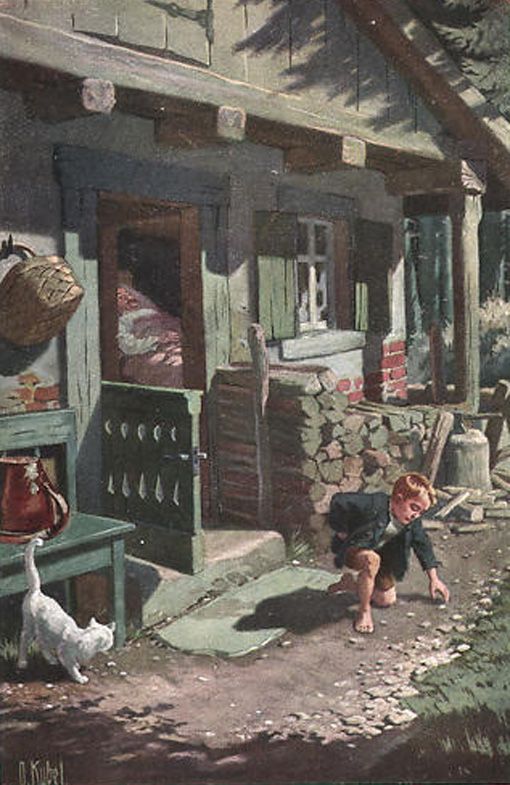 Image: Otto Kubel (1868 – 1951)
Image: Otto Kubel (1868 – 1951)When the day was breaking, and before the sun had risen, the wife came and awakened the two children, saying, „Get up, you lazy bones. We are going into the forest to cut wood.“ Then she gave each of them a piece of bread, and said, „That is for dinner, and you must not eat it before then, for you will get no more.“
Grethel carried the bread under her apron, for Hansel had his pockets full of the flints. Then they set off all together on their way to the forest. When they had gone a little way Hansel stood still and looked back towards the house, and this he did again and again, till his father said to him, „Hansel, what are you looking at? take care not to forget your legs.“
„O father,“ said Hansel, „lam looking at my little white kitten, who is sitting up on the roof to bid me good-bye.“ – „You young fool,“ said the woman, „that is not your kitten, but the sunshine on the chimney-pot.“ Of course Hansel had not been looking at his kitten, but had been taking every now and then a flint from his pocket and dropping it on the road.
When they reached the middle of the forest the father told the children to collect wood to make a fire to keep them, warm; and Hansel and Grethel gathered brushwood enough for a little mountain j and it was set on fire, and when the flame was burning quite high the wife said, „Now lie down by the fire and rest yourselves, you children, and we will go and cut wood; and when we are ready we will come and fetch you.“
So Hansel and Grethel sat by the fire, and at noon they each ate their pieces of bread. They thought their father was in the wood all the time, as they seemed to hear the strokes of the axe: but really it was only a dry branch hanging to a withered tree that the wind moved to and fro. So when they had stayed there a long time their eyelids closed with weariness, and they fell fast asleep.
When at last they woke it was night, and Grethel began to cry, and said, „How shall we ever get out of this wood? „But Hansel comforted her, saying, „Wait a little while longer, until the moon rises, and then we can easily find the way home.“ And when the full moon got up Hansel took his little sister by the hand, and followed the way where the flint stones shone like silver, and showed them the road.
They walked on the whole night through, and at the break of day they came to their father’s house. They knocked at the door, and when the wife opened it and saw that it was Hansel and Grethel she said, „You naughty children, why did you sleep so long in the wood? we thought you were never coming home again!“ But the father was glad, for it had gone to his heart to leave them both in the woods alone.
Not very long after that there was again great scarcity in those parts, and the children heard their mother say at night in bed to their father, „Everything is finished up. We have only half a loaf, and after that the tale comes to an end. The children must be off. We will take them farther into the wood this time, so that they shall not be able to find the way back again. There is no other way to manage.“ The man felt sad at heart, and he thought, „It would better to share one’s last morsel with one’s children.“
But the wife would listen to nothing that he said, but scolded and reproached him. He who says A must say B too, and when a man has given in once he has to do it a second time. But the children were not asleep, and had heard all the talk. When the parents had gone to sleep Hansel got up to go out and get more flint stones, as he did before, but the wife had locked the door, and Hansel could not get out; but he comforted his little sister, and said, „Don’t cry, Grethel, and go to sleep quietly, and God will help us.“
Early the next morning the wife came and pulled the children out of bed. She gave them each a little piece of „bread -less than before; and on the way to the wood Hansel crumbled the bread in his pocket, and often stopped to throw a crumb on the ground. „Hansel, what are you stopping behind and staring for?“ said the father. „I am looking at my little pigeon sitting on the roof, to say good-bye to me,“ answered Hansel. „You fool,“ said the wife, „that is no pigeon, but the morning sun shining on the chimney pots.“ Hansel went on as before, and strewed bread crumbs all along the road.
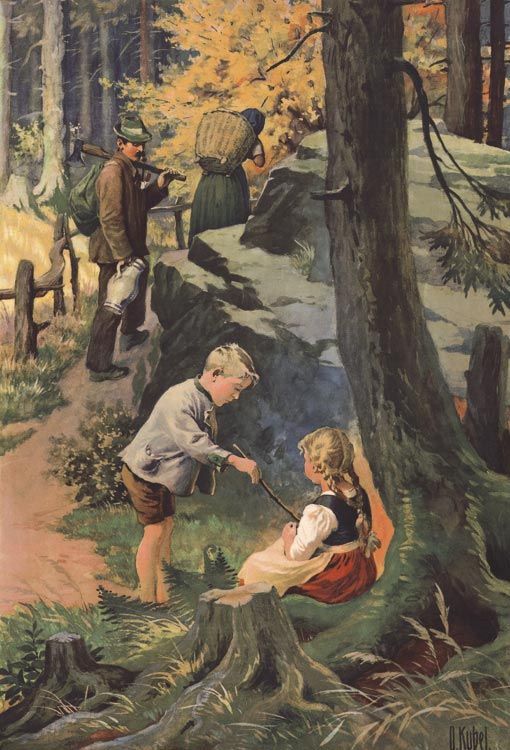 Image: Otto Kubel (1868 – 1951)
Image: Otto Kubel (1868 – 1951)The woman led the children far into the wood, where they had never been before in all their lives. And again there was a large fire made, and the mother said, „Sit still there, you children, and when you are tired you can go to sleep. We are going into the forest to cut wood, and in the evening, when we are ready to go home we will come and fetch you.“
So when noon came Grethel shared her bread with Hansel, who had strewed his along the road. Then they went to sleep, and the evening passed, and no one came for the poor children. When they awoke it was dark night, and Hansel comforted his little sister, and said, „Wait a little, Grethel, until the moon gets up, then we shall be able to see the way home by the crumbs of bread that I have scattered along it.“
So when the moon rose they got up, but they could find no crumbs of bread, for the birds of the woods and of the fields had come and picked them up. Hansel thought they might find the way all the same, but they could not. They went on all that night, and the next day from the morning until the evening, but they could not find the way out of the wood, and they were very hungry, for they had nothing to eat but the few berries they could pick up. And when they were so tired that they could no longer drag themselves along, they lay down under a tree and fell asleep.
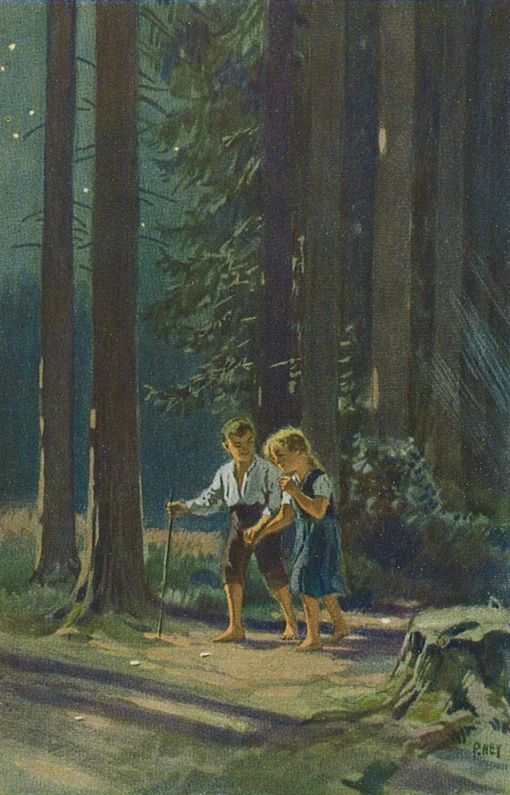 Image: Paul Hey (1867 – 1952)
Image: Paul Hey (1867 – 1952)It was now the third morning since they had left their father’s house. They were always trying to get back to it, but instead of that they only found themselves farther in the wood, and if help had not soon come they would have been starved. About noon they saw a pretty snow-white bird sitting on a bough, and singing so sweetly that they stopped to listen. And when he had finished the bird spread his wings and flew before them, and they followed after him until they came to a little house, and the bird perched on the roof, and when they came nearer they saw that the house was built of bread, and roofed with cakes; and the window was of transparent sugar.
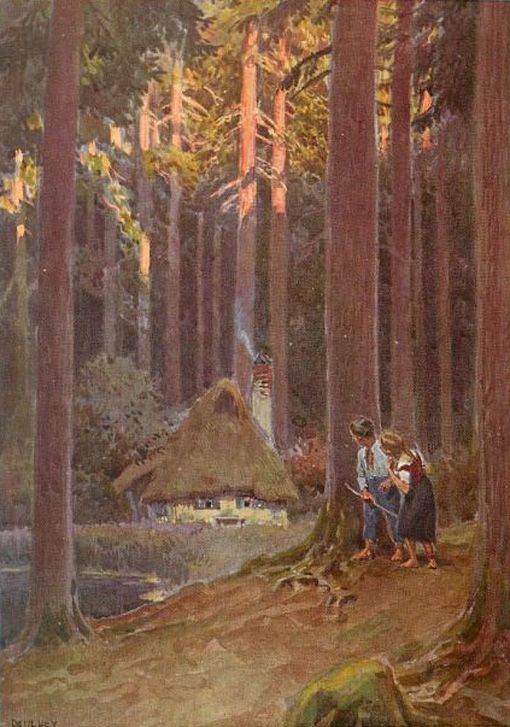 Image: Paul Hey (1867 – 1952)
Image: Paul Hey (1867 – 1952)„We will have some of this,“ said Hansel, „and make a fine meal. I will eat a piece of the roof, Grethel, and you can have some of the window-that will taste sweet.“ So Hansel reached up and broke off a bit of the roof, just to see how it tasted, and Grethel stood by the window and gnawed at it. Then they heard a thin voice call out from inside,
„Nibble, nibble, like a mouse. Who is nibbling at my house?“ And the children answered, „Never mind, It is the wind.“
And they went on eating, never disturbing themselves. Hansel, who found that the roof tasted very nice, took down a great piece of it, and Grethel pulled out a large round window-pane, and sat her down and began upon it. Then the door opened, and an aged woman came out, leaning upon a crutch. Hansel and Grethel felt very frightened, and let fall what they had in their hands.
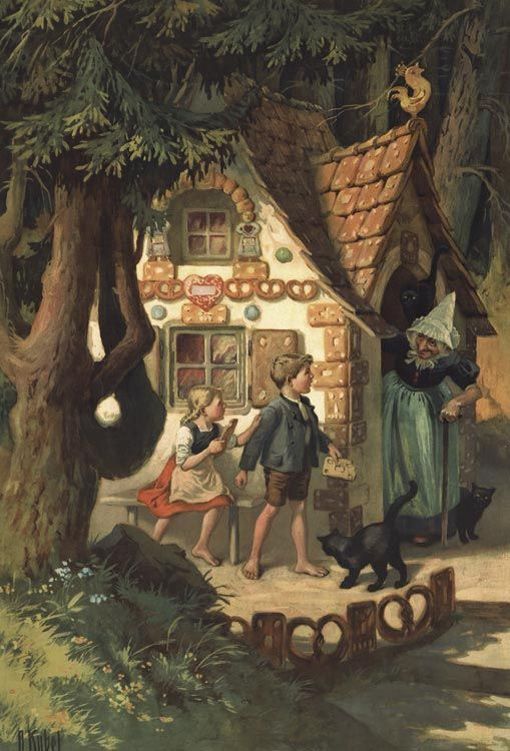 Image: Otto Kubel (1868 – 1951)
Image: Otto Kubel (1868 – 1951)The old woman, however, nodded her head, and said, „Ah, my dear children, how come you here? you must come indoors and stay with me, you will be no trouble.“ So she took them each by the hand, and led them into her little house. And there they found a good meal laid out, of milk and pancakes, with sugar, apples, and nuts. After that she showed them two little white beds, and Hansel and Grethel laid themselves down on them, and thought they were in heaven.
The old woman, although her behaviour was so kind, was a wicked witch, who lay in wait for children, and had built the little house on purpose to entice them. When they were once inside she used to kill them, cook them, and eat them, and then it was a feast day with her. The witch’s eyes were red, and she could not see very far, but she had a keen scent, like the beasts, and knew very well when human creatures were near. When she knew that Hansel and Grethel were coming, she gave a spiteful laugh, and said triumphantly, „I have them, and they shall not escape me!“
Early in the morning, before the children were awake, she got up to look at them, and as they lay sleeping so peacefully with round rosy cheeks, she said to herself, „What a fine feast I shall have!“ Then she grasped Hansel with her withered hand, and led him into a little stable, and shut him up behind a grating; and call and scream as he might, it was no good. Then she went back to Grethel and shook her, crying, „Get up, lazy bones; fetch water, and cook something nice for your brother. He is outside in the stable, and must be fattened up. And when he is fat enough I will eat him.“ Grethel began to weep bitterly, but it was of no use, she had to do what the wicked witch bade her.
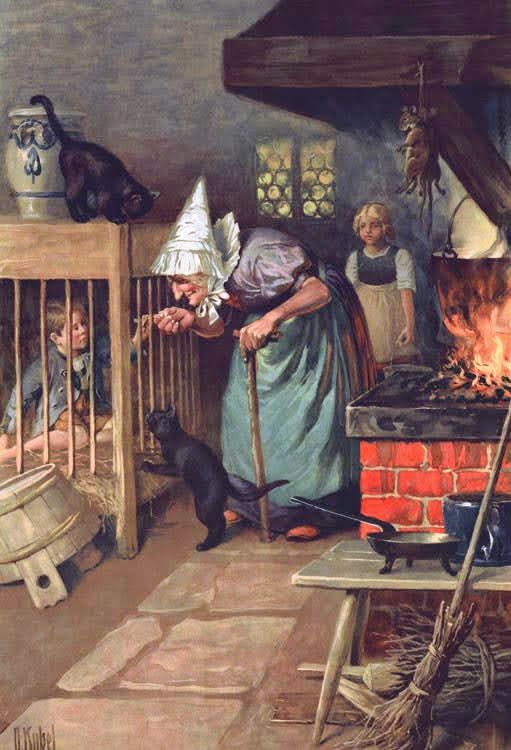 Image: Otto Kubel (1868 – 1951)
Image: Otto Kubel (1868 – 1951)And so the best kind of victuals was cooked for poor Hansel, while Grethel got nothing but crab-shells. Each morning the old woman visited the little stable, and cried, „Hansel, stretch out your finger, that I may tell if you will soon be fat enough.“ Hansel, however, used to hold out a little bone, and the old woman, who had weak eyes, could not see what it was, and supposing it to be Hansel’s finger, wondered very much that it was not getting fatter.
When four weeks had passed and Hansel seemed to remain so thin, she lost patience and could wait no longer. „Now then, Grethel,“ cried she to the little girl; „be quick and draw water; be Hansel fat or be he lean, tomorrow I must kill and cook him.“ Oh what a grief for the poor little sister to have to fetch water, and how the tears flowed down over her cheeks! „Dear God, pray help us!“ cried she; „if we had been devoured by wild beasts in the wood at least we should have died together.“
„Spare me your lamentations,“ said the old woman; „they are of no avail.“ Early next morning Grethel had to get up, make the fire, and fill the kettle. „First we will do the baking,“ said the old woman; „I nave heated the oven already, and kneaded the dough.“ She pushed poor Grethel towards the oven, out of which the flames were already shining. „Creep in,“ said the witch, „and see if it is properly hot, so that the bread may be baked.“ And Grethel once in, she meant to shut the door upon her and let her be baked, and then she would have eaten her. But Grethel perceived her intention, and said, „I don’t know how to do it: how shall I get in?“
„Stupid goose,“ said the old woman, „the opening is big enough, do you see? I could get in myself!“ and she stooped down and put her head in the oven’s mouth. Then Grethel gave her a push, so that she went in farther, and she shut the iron door upon her, and put up the bar. Oh how frightfully she howled! but Grethel ran away, and left the wicked witch to burn miserably.
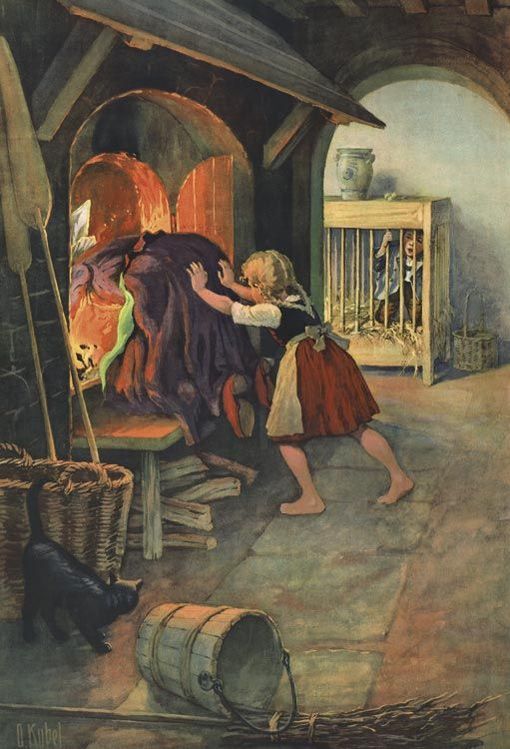 Image: Otto Kubel (1868 – 1951)
Image: Otto Kubel (1868 – 1951)Grethel went straight to Hansel, opened the stable-door, and cried, „Hansel, we are free! the old witch is dead!“ Then out flew Hansel like a bird from its cage as soon as the door is opened. How rejoiced they both were! how they fell each on the other’s neck! and danced about, and kissed each other! And as they had nothing more to fear they went over all the old witch’s house, and in every corner there stood chests of pearls and precious stones.
„This is something better than flint stones,“ said Hansel, as he filled his pockets, and Grethel, thinking she also would like to carry something home with her, filled her apron full. i! Now, away we go,“ said Hansel, „if we only can get out of the witch’s wood.“ When they had journeyed a few hours they came to a great piece of water. „We can never get across this,“ said Hansel, „I see no stepping-stones and no bridge.“ – „And there is no boat either,“ said Grethel. „But here comes a white duck. If I ask her she will help us over.“ So she cried,
„Duck, duck, here we stand. Hansel and Grethel, on the land. Stepping-stones and bridge we lack. Carry us over on your nice white back.“
And the duck came accordingly, and Hansel got upon her and told his sister to come too. „No,“ answered Grethel, „that would be too hard upon the duck. We can go separately, one after the other.“ And that was how it was managed, and after that they went on happily, until they came to the wood, and the way grew more and more familiar, till at last they saw in the distance their father’s house. Then they ran till they came up to it, rushed in at the door, and fell on their father’s neck.
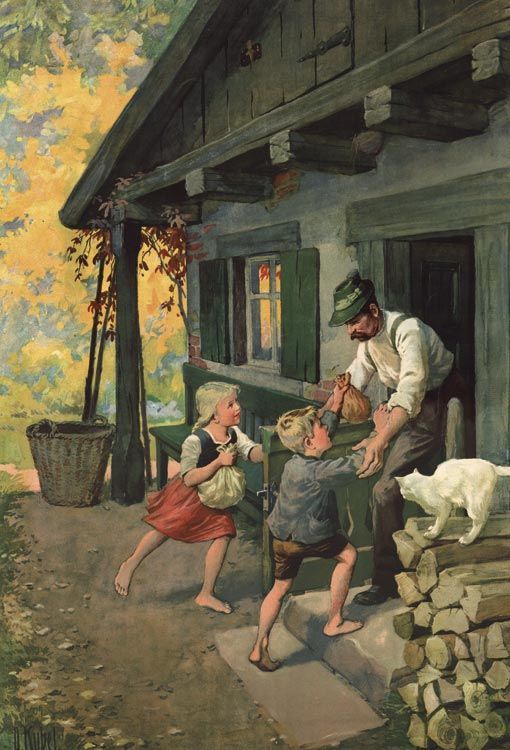 Image: Otto Kubel (1868 – 1951)
Image: Otto Kubel (1868 – 1951)The man had not had a quiet hour since he left his children in the wood; but the wife was dead. And when Grethel opened her apron the pearls and precious stones were scattered all over the room, and Hansel took one handful after another out of his pocket. Then was all care at an end, and they lived in great joy together. My tale is done, there runs a mouse, whosoever catches it, may make himself a big fur cap out of it.
Backgrounds to fairy tale „Hansel and Gretel“
„Hansel and Gretel“ is a well-known fairy tale from the Brothers Grimm collection. Like many other fairy tales, „Hansel and Gretel“ has its origins in the oral tradition, with the story being passed down through generations by word of mouth. The Grimm brothers collected and recorded the tale as part of their efforts to preserve German folklore.
The story is an example of German folklore, featuring characters, settings, and themes that are typical of tales from the region. The dark forest, the gingerbread house, and the wicked witch are all elements that contribute to the distinctive atmosphere of this classic tale. The story of „Hansel and Gretel“ reflects the hardships that many people faced during times of famine and scarcity. The theme of child abandonment and the lengths to which the parents go to ensure their own survival highlight the harsh realities that some families experienced.
„Hansel and Gretel“ contains several common folk motifs found in fairy tales across different cultures. These include the resourceful child, the evil stepmother, the magical helper, and the triumph of good over evil. Jacob and Wilhelm Grimm were German academics, linguists, and cultural researchers who dedicated themselves to collecting and preserving the folktales of their country. „Hansel and Gretel“ is one of the most well-known stories in their famous anthology.
The story of „Hansel and Gretel“ shares similarities with other folktales and legends, such as the Russian tale of „Baba Yaga“ and the English story of „Tom Thumb.“ The exchange of stories between different cultures and regions may have influenced the development and evolution of these tales. In summary, „Hansel and Gretel“ has its roots in the oral storytelling tradition and German folklore. Collected by the Brothers Grimm as part of their efforts to preserve the cultural history of their country, the story includes common folk motifs and shares elements with other tales, contributing to its rich background and enduring appeal.
The story takes place in a time of famine and follows the lives of Hansel and Gretel, a young brother and sister whose family is struggling to survive. Their stepmother convinces their father, a poor woodcutter, to abandon the children in the forest, hoping to increase the family’s chances of survival. However, Hansel and Gretel are clever and resourceful. They leave a trail of breadcrumbs to find their way back home. Unfortunately, wild animals eat the breadcrumbs, leaving the children lost in the woods. They eventually stumble upon a gingerbread house, where they meet a wicked witch who intends to fatten them up and eat them.
Through their resourcefulness and intelligence, Hansel and Gretel manage to outsmart the witch and escape. They return home with the witch’s treasures, only to find that their stepmother has passed away. Their father, overjoyed to see them, welcomes them back, and the family is reunited, living happily ever after. The tale of Hansel and Gretel has resonated with readers for generations, offering valuable lessons about survival, resourcefulness, family bonds, and the triumph of good over evil.
Interpretations to fairy tale „Hansel and Gretel“
„Hansel and Gretel“ is a classic fairy tale from the Brothers Grimm collection that can be interpreted in various ways, offering different perspectives on its themes and messages:
Overcoming adversity: The story demonstrates the power of resourcefulness and resilience, as the siblings use their wits and determination to escape danger and eventually triumph over the witch. This theme of overcoming adversity and finding inner strength is at the heart of the tale.
Sibling bond: Hansel and Gretel rely on each other for support and protection throughout the story, showcasing the strength of sibling bonds. Their teamwork and love for each other play a crucial role in their survival and ultimate victory.
The danger of greed and temptation: The gingerbread house and the witch’s deceptive appearance symbolize the dangers of succumbing to temptation and being lured in by false promises. The story serves as a cautionary tale about the consequences of being blinded by desire and greed.
The evil stepmother archetype: The story features an evil stepmother who plots to abandon the children due to scarcity of resources. This character represents a common trope in fairy tales, where the stepmother is often portrayed as wicked and cruel, further emphasizing the story’s themes of adversity and survival.
Cleverness and cunning: Hansel and Gretel use their intelligence to outsmart the witch, dropping breadcrumbs to find their way back and deceiving her with various tricks. This theme of using cleverness and cunning to overcome obstacles is a recurring motif in many fairy tales.
Good versus evil: The story presents a clear battle between good and evil, with the innocent siblings pitted against the wicked witch. The ultimate victory of good over evil serves to reinforce the moral lessons of the tale. The innocence of Hansel and Gretel is contrasted with the wickedness of the witch. Their ability to maintain their innocence and purity ultimately enables them to overcome the evil that seeks to destroy them.
The role of the forest: The forest in „Hansel and Gretel“ represents both danger and refuge, acting as a symbol of the unknown and the wild. The siblings must navigate the perils of the forest in order to return to safety, highlighting the theme of navigating the challenges and uncertainties of life.
The Struggle for Survival: The story highlights the challenges faced by the family during times of scarcity and famine. It demonstrates the tough decisions parents had to make to ensure their family’s survival, even if it meant abandoning their children.
Resourcefulness and Resilience: Hansel and Gretel’s ability to use their resourcefulness and intelligence to survive in the face of adversity is a central theme in the story. They use their wits to outsmart the witch, ultimately leading to their escape and triumph over evil.
The Importance of Family Bonds: Despite their parents‘ decision to abandon them, Hansel and Grethel’s bond with each other remains strong. Their love and support for each other help them overcome the challenges they face, reinforcing the importance of family connections.
The Dangers of Greed and Gluttony: The witch’s desire to consume the children is a cautionary tale about the dangers of greed and gluttony. Her ultimate demise serves as a warning against the destructive nature of these vices.
Faith and Trust: Throughout the story, Hansel and Grethel exhibit a strong faith and trust in a higher power, which helps them navigate the challenges they face. Their belief in a guiding force helps them persevere, even when it seems all hope is lost.
Overall, „Hansel and Gretel“ offers a range of interpretations, exploring themes such as overcoming adversity, the bond between siblings, the dangers of greed and temptation, the evil stepmother archetype, the power of cleverness and cunning, good versus evil, and the role of the forest in the story.
Adaptions of the fairy tale „Hansel and Gretel“
„Hansel and Gretel“ is a popular fairy tale from the Brothers Grimm collection and has been adapted in various forms over the years. Here are some specific examples of its adaptations:
Films and television: „Hansel and Gretel“ has been adapted into numerous films and TV shows, ranging from live-action movies to animated series. Examples include the 1987 film „Cannon Movie Tales: Hansel and Gretel“ and the 2013 action-horror film „Hansel & Gretel: Witch Hunters.“ The story has been adapted into several animated television shows, including the 1980s series „Grimm’s Fairy Tale Classics“ and the 2010s series „Once Upon a Time.“ The tale has been adapted into several films over the years, including the 1954 film „Hansel and Gretel“ and the 2013 film „Hansel & Gretel: Witch Hunters,“ which reimagines the siblings as adult witch hunters.
Theater productions: The story has been adapted for the stage in various formats, such as plays and musicals. For instance, „Hansel and Gretel: A Wickedly Delicious Musical Treat“ by Bruce Craig Miller and Ford Flannagan is a musical adaptation for young audiences. One of the most famous adaptations of Hansel and Gretel is the opera by Engelbert Humperdinck, which premiered in 1893. The opera features music that is inspired by traditional German folk songs and tells the story of the siblings‘ journey through the forest and their encounter with the witch. Hansel and Gretel has been adapted into several stage productions, including ballets, musicals, and plays. The most notable of these is perhaps the ballet version by choreographer George Balanchine, which premiered in 1954.
Illustrated children’s books: „Hansel and Gretel“ has been published in numerous illustrated children’s books, featuring different artistic styles and interpretations of the story. Some editions, like „Hansel and Gretel“ illustrated by Rika Lesser and Paul O. Zelinsky, have received awards for their artwork. The tale has been retold in numerous children’s books, including adaptations by James Orchard Halliwell, Paul O. Zelinsky, and Neil Gaiman. These retellings often add new elements to the story, such as more developed characters or modern settings.
Parodies and reinterpretations: The story has inspired parodies and reinterpretations that put a unique spin on the classic tale. For example, the graphic novel „Hansel & Gretel“ by Neil Gaiman and Lorenzo Mattotti presents a darker, more unsettling version of the story.
Theme parks and attractions: The tale of Hansel and Gretel has also been used as inspiration for theme park attractions, such as the „Hansel and Gretel’s Candy Kitchen“ ride at the Efteling theme park in the Netherlands.
Opera: Engelbert Humperdinck’s „Hansel and Gretel“ is a well-known opera adaptation that premiered in 1893. The opera stays true to the original story while adding its own unique musical elements.
Ballet: The story has been adapted into ballet productions, with choreographers creating original works inspired by the fairy tale. For instance, the Royal Winnipeg Ballet has performed a ballet version of „Hansel and Gretel.“
„Hansel and Gretel“ is a German fairy tale that has been widely popularized through its inclusion in the Brothers Grimm’s collection, „Grimms‘ Fairy Tales.“ The story was first published in 1812, but its origins can be traced back to European folktales that predate the Grimm Brothers‘ collection. It has been adapted and retold in various forms, including stage plays, operas, films, and even ballets. These adaptations demonstrate the enduring appeal and versatility of „Hansel and Gretel“ across various forms of media and art. The fairy tale continues to inspire new generations of artists and audiences, with its timeless themes and engaging narrative.
Summary of the plot
„Hansel and Gretel“ is a classic fairy tale from the Brothers Grimm collection that tells the story of a brother and sister who must navigate a treacherous forest and outwit a wicked witch to survive. The tale begins with a poor woodcutter, his wife, and their two children, Hansel and Gretel. Due to a severe famine, the stepmother convinces the woodcutter to abandon the children in the forest, believing they will have a better chance of survival without them. Hansel, overhearing the plan, gathers pebbles to drop as a trail to find their way home. The first time they are abandoned, the siblings successfully follow the pebble trail back to their house.
However, the second time the woodcutter leaves them in the forest, Hansel is only able to drop breadcrumbs, which are eaten by birds, causing the siblings to lose their way. As they wander through the forest, they come across a house made of gingerbread and candy, which they eagerly begin to eat. Unbeknownst to them, the house belongs to a wicked witch who uses it to lure children, intending to fatten them up and eat them. The witch captures Hansel and Gretel, imprisoning Hansel in a cage and forcing Gretel to do housework. The witch plans to cook and eat Hansel once he becomes plump enough, but the clever siblings manage to outsmart her. Every time the witch checks Hansel’s plumpness, he presents a thin bone instead of his finger, tricking her into believing he is not gaining weight.
Finally, the witch grows impatient and decides to eat Hansel regardless of his size. As she prepares the oven, Gretel pretends not to understand how to check if the oven is hot enough. The witch, annoyed, leans in to demonstrate, and Gretel pushes her into the oven, locking the door behind her. The witch is burned to death, and the children are freed. Hansel and Gretel discover a stash of treasure in the witch’s house and take it with them as they make their way back home. When they arrive, they find that their stepmother has died, and their father is overjoyed to see them. With the witch’s treasure, the family is no longer poor, and they live happily ever after. „Hansel and Gretel“ is a tale of resourcefulness, sibling bonds, and triumph over adversity, featuring memorable characters and a thrilling narrative that continues to captivate readers and audiences today.
Abstract
In the fairy tale „Hansel and Gretel“ by Brothers Grimm, a poor woodcutter and his wife, unable to feed their children, decide to abandon them in the forest. Hansel, overhearing this plan, gathers flint stones to help them find their way back home. The parents lead the children into the forest, where Hansel drops the flints to mark their path. After being left by their parents, Hansel and Gretel eventually find their way back using the flints.
However, there’s another scarcity in the land, and the parents decide to abandon the children again. This time, Hansel uses breadcrumbs as a trail, but birds eat the crumbs, leaving them lost in the woods. They wander until they find a house made of bread, cakes, and sugar, where a seemingly kind old woman lives. She offers them food and shelter, but turns out to be a wicked witch who wants to eat the children.
The witch imprisons Hansel and forces Gretel to cook and fatten him up for eating. Hansel tricks the witch into thinking he isn’t getting fat by offering her a bone instead of his finger. When the witch loses patience, she decides to eat Hansel regardless of his weight and orders Gretel to prepare the oven. Gretel, seizing an opportunity, tricks the witch into checking the oven’s heat and pushes her inside, locking the door.
Gretel frees Hansel, and they discover chests full of pearls and precious stones in the witch’s house. They fill their pockets and apron with the treasures and use the white bird that led them to the house to guide them back home. When they return, they find their father overjoyed to see them, as their stepmother had died. With the witch’s treasures, the family is no longer poor and lives happily ever after.
Informations for scientific analysis
Fairy tale statistics | Value |
|---|---|
| Number | KHM 15 |
| Aarne-Thompson-Uther-Index | ATU Typ 327A |
| Translations | DE, EN, EL, DA, ES, FR, PT, FI, HU, IT, JA, NL, PL, RO, RU, TR, VI, ZH, |
| Readability Index by Björnsson | 27.8 |
| Flesch-Reading-Ease Index | 83.9 |
| Flesch–Kincaid Grade-Level | 6.3 |
| Gunning Fog Index | 8.5 |
| Coleman–Liau Index | 7.4 |
| SMOG Index | 6.9 |
| Automated Readability Index | 6.7 |
| Character Count | 14.978 |
| Letter Count | 11.365 |
| Sentence Count | 151 |
| Word Count | 2.879 |
| Average Words per Sentence | 19,07 |
| Words with more than 6 letters | 251 |
| Percentage of long words | 8.7% |
| Number of Syllables | 3.526 |
| Average Syllables per Word | 1,22 |
| Words with three Syllables | 62 |
| Percentage Words with three Syllables | 2.2% |















